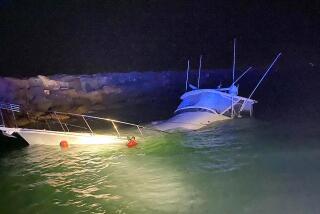Prosecutor Seeks 2nd Manslaughter Trial in 5 Power Boat Deaths
- Share via
A prosecutor announced Tuesday that he will seek another manslaughter trial for the operator of a power boat that collided with a buoy and left five people dead.
The decision came despite a first jury’s lopsided vote for acquittal on manslaughter charges.
Superior Court Judge Jean H. Rheinheimer will hold a hearing Feb. 28 to determine whether to dismiss the case or grant the district attorney’s request for a second trial of Virl H. Earles, 30, of Seal Beach.
Earles, who had shown up in court Tuesday expecting prosecutors to dismiss the charges, was disappointed and angry.
“This is terrible,” Earles said. “Why do we have to go through this all over again?”
Jury Deadlocked
Last month, a jury in Westminster deadlocked 9 to 3 on five counts of involuntary manslaughter, forcing Rheinheimer to declare a mistrial. The majority of the jurors favored acquitting Earles.
Orange County Deputy Dist. Atty. John D. Conley said at the time that he probably would not try to prosecute Earles again unless his office came up with new evidence.
Conley said outside court Tuesday that no new evidence has developed but that he will press for a second trial.
“I think he (Earles) is responsible for what happened,” Conley said. “I respectfully disagree with the conclusions of the first jury.”
Trip to Long Beach
Earles and eight passengers had left Peter’s Landing in Huntington Harbour in a six-seat power boat on Oct. 28, 1984, for an after-midnight trip to Long Beach to view the Queen Mary.
After re-entering Anaheim Bay on the return trip, Earles mistakenly drove the boat nearly 100 yards outside the safe boating channel and struck a concrete Navy mooring buoy head-on. Only four on the boat survived. Two of them, Carol Kemble, 25, of Laguna Beach, and Ernest Chavez, 25, of Bakersfield, perched on the buoy after the crash and, despite their own injuries, held Earles’ head out of the water as he lapsed in and out of consciousness. The fourth survivor, Stephen Brennan, 24, of Huntington Beach, managed to swim ashore for help despite a broken pelvis and internal bleeding.
The five killed were Anthony Sutton, 27, Ronald Myers, 22 and John Bakos, 22, all of Seal Beach; Kathy Weaver, 24, of Laguna Beach, and Patricia Hulings, 20, of Downey.
Earles, a construction worker, still is recovering from injuries he suffered in the crash.
He said that improper navigational lights marking the entrance to the bay caused him to miss the channel and head straight toward the unlit buoy. The boat crashed within a few seconds after entering the mouth of the bay.
But prosecutor Conley argued that Earles, by his own admission, was driving at least 30 m.p.h. inside the bay, which has a speed limit of 5 m.p.h.
Conley also contended that the boat was without life jackets and that Earles should have been extra cautious knowing that the boat was overloaded with passengers.
But Conley lost the chance to utilize an important piece of evidence before the trial even began.
Tests on Earles’ blood showed a .11 blood alcohol level, slightly above the state law’s minimum requirement for a presumption of drunk driving by motorists.
Courts have permitted prosecutors to use blood alcohol levels as evidence of unsafe boat driving.
Evidence Ruled Out
But a Municipal Court judge ruled that Earles’ alcohol test had been illegally conducted by police and prohibited its use in court.
Several jurors who voted for acquittal said later that they agreed with Earles’ attorney, Gary M. Pohlson, who had called the incident “a tragic accident, but still an accident.”
Conley said Tuesday that he believes some of his witnesses can help clarify questions that puzzled the first jury about the harbor conditions the night of the boat collision.
Asked if that might be enough to win a conviction, Conley said: “I don’t know. I just think we have to try.”
Conley and Pohlson said they cannot predict whether Rheinheimer will let a second trial take place.
“I certainly think she should dismiss it after all my client has gone through,” Pohlson said.
More to Read
Sign up for Essential California
The most important California stories and recommendations in your inbox every morning.
You may occasionally receive promotional content from the Los Angeles Times.












